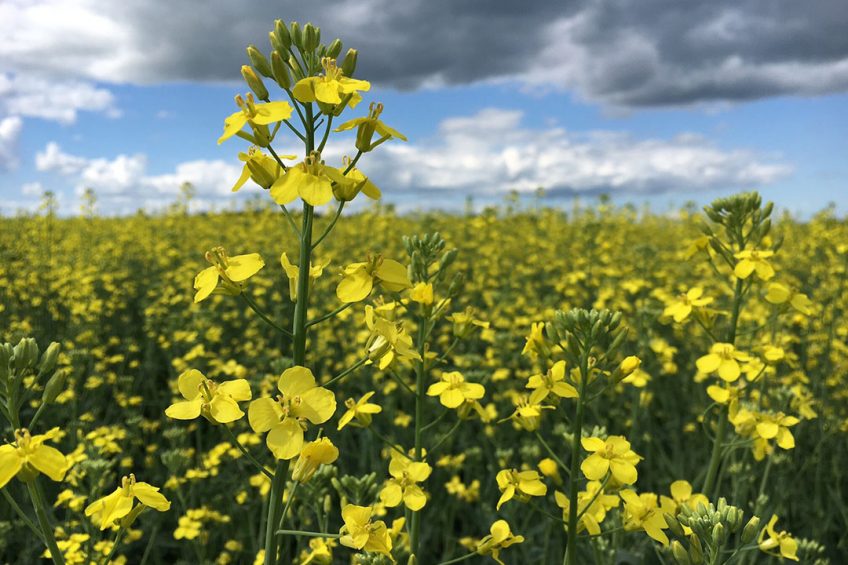Canola meal in pig diets: inroads around the world

Because canola meal is high in protein and acreage of the crop has increased in Europe, Canada, the US and Australia, the feed ingredient has made strong inroads into the diets of many livestock species, especially dairy cattle and swine.
Taking a look back at the history of canola meal use, Dr Rex Newkirk notes that decades ago it contained enough glucosinolates to cause feed intake concerns, but breeding of the crop has reduced the level to almost nothing. According to Newkirk, who is associate professor at the University of Saskatchewan in Canada and that province’s Ministry of Agriculture Endowed Research Chair in Feed Processing Technology, it’s quite well known around the world that today’s canola meal has no palatability issues. Breeding, along with improved agronomic practices and processing methods, has also greatly boosted its consistency.
However, Newkirk notes that “I think there is still some caution required regarding meal from some regions [of the world] where canola meal and rapeseed meal are not segregated effectively”. He adds that “a common issue that seems to hold back growth [of its use] in some of the traditional soybean markets, such as Asia, is the colour.” Canola meal makes for darker diets than those made primarily with corn and soybean, but he notes that as experience with canola meal is gained, colour typically becomes a non-issue.
Used pretty extensively in swine
According to Newkirk, canola meal is used pretty extensively in swine in regions where it’s produced, such as Western Canada, Australia and Europe. He adds that in Canada, “a reasonable portion of our swine and poultry production on the Canadian Prairies is on Hutterite colonies, and they tend to make pretty extensive use of canola meal, especially if they crush their own seed.”
University of Illinois professor Dr Hans Stein notes that research over the last ten years in the US and Canada has concluded that canola meal can fully replace soybean meal in diets for growing and finishing pigs and also for sows without reductions in animal performance. (According to the Canola Council of Canada [CCC], except for lysine, canola meal provides an amino acid balance that targets a pig’s required amino acid profile better than any other plant protein.)
If you want to use canola meal in many parts of the US, you need to pay for trucking it from far away and that increases the cost
However, usage of canola meal in the US pig industry “is really low”, says Stein, “because we have soybean meal (SBM) easily available and, with the exception of a few states (Minnesota, North Dakota), canola meal is more expensive because we only crush soybeans and not canola. There is a little bit of canola grown in Minnesota and North Dakota and they crush those seeds there, but most of the meal goes into dairy feed rather than pig feed. If you want to use canola meal in many parts of the US, you need to pay for trucking it from far away and that increases the cost. So, it’s an economic decision to use SBM more than it is a nutritional decision.”
Lower energy content
Dr Denise Beaulieu, assistant professor at University of Saskatchewan, notes that canola meal can also cost more than SBM because of its lower energy content. “Research has demonstrated that if we formulate our rations using the net energy system and standardised ileal digestible amino acids, performance can be maintained when canola meal is substituted for SBM,” she explains. “However, utilising least-cost formulation, canola meal must be priced between 60% and 70% of the cost of SBM to come into our rations.”
Research roundup
Research conducted in 2019 by the University of Alberta and by the Alberta government’s Ministry of Agriculture and Forestry showed that there was very minimal variation in the Standardized Ileal Digestibility (SID) for canola meal obtained from five canola meal processing plants in Canada in five different geographic regions. The CCC has supported the determination of SID values for both solvent-extracted and expeller-extracted meal in order to provide the feed industry with reliable values for diet formulation.
Cold pressed extraction
A lesser used method of oil extraction, “cold pressed” extraction, is similar to expeller meal. Brittany Dyck, CCC’s canola meal manager, points to a study published earlier this year in the Journal of Animal Feed Science and Technology by researchers at South Dakota State University that provided values for cold-pressed expeller meal for pigs. Its SID value was quite close to the values for expeller canola meal in the most recently published CCC Canola Meal Feeding Guide (it can be downloaded in English, Spanish and Mandarin free of charge).
Dyck points to the 2020 published study of another research group, led by Dr Olayiwola Adeola at Purdue University, which investigated the SID of full-fat canola seeds for pigs. The team found that ground seeds are high in both energy and protein and can therefore be easily incorporated into rations for swine. “The amino acids in this ingredient are also readily digested by growing pigs,” says Dyck.
She adds that while data on SID are almost exclusively determined with growing pigs, research published in 2019 from the Nyachoti Lab at the University of Manitoba found that SID of canola meal is greater for adult sows than for growing pigs. The researchers also determined that the SID values of arginine, histidine, lysine, methionine, tryptophan and valine were greater with a treatment of a multicarbohydrase enzyme.
Additional research from the University of Manitoba presented in 2020 evaluated the effects of heat treatment on phosphorus digestibility. The results found that phytase enzymes should be used in order to increase phosphorus availability of canola meal in swine diets.
A bright future
Newkirk believes use of canola meal in pigs, poultry and beyond will continue to grow because consistency is excellent and it’s a fully palatable ingredient for pigs. “Much of the world has become highly dependent on SBM, but with price fluctuations and trade barriers they are always looking for alternatives,” he adds. “Once they get some experience with canola meal, they usually increase the use.”
The varieties of canola we have today can result in very good pig performance
When recently doing seminars in Malaysia, Newkirk says he was left with the impression that there may be significant growth for canola meal in that market. “Price-wise it made sense,” he says. “The nutritionists just need to get more familiar and comfortable with it.”
For his part, Stein does not expect usage of canola meal to increase significantly in the US because SBM is likely to remain less expensive on an amino acid basis. “But of course in western Canada, in Europe, and in other parts of the world where canola but not soybeans can be grown, I think we can easily see an increase in canola meal usage in swine diets because, as mentioned, pigs perform very well on canola meal diets. I think the varieties of canola we have today can result in very good pig performance.”
He adds that “we now have high-protein canola available. These varieties result in canola meal with 44–48% crude protein and they are very interesting to use in pig diets. So, this will likely also contribute to increased usage of canola in the future.”











